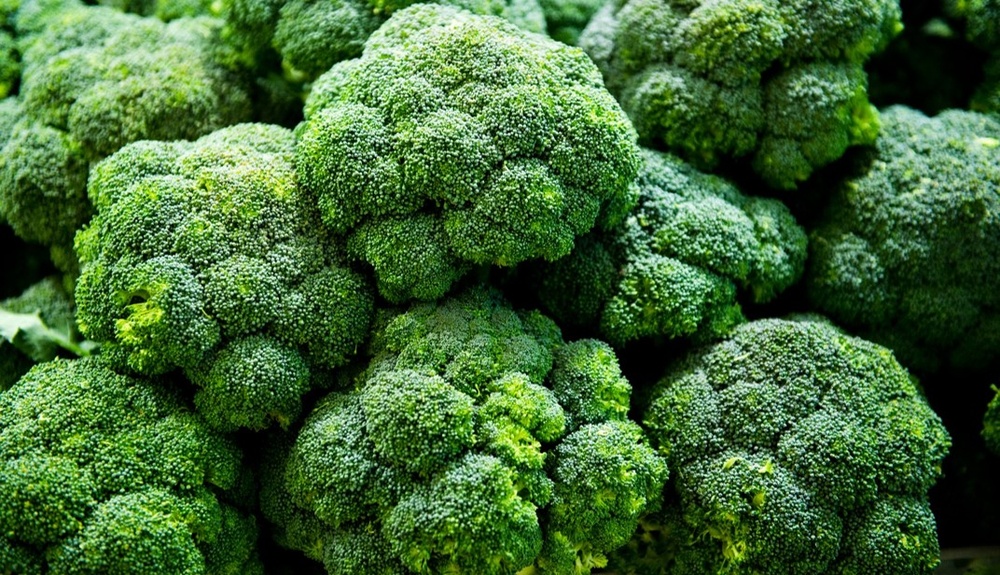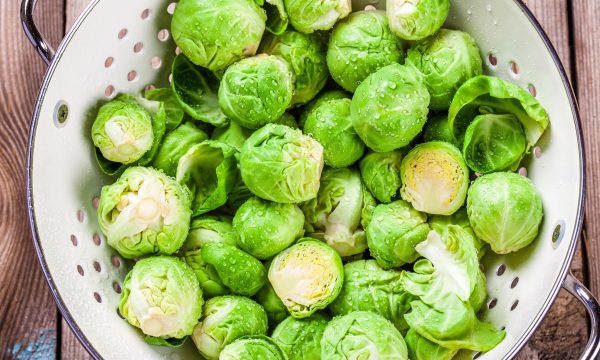Serve Bountiful, Flavorful Broccoli This Fall
Are you are falling back into old, unhealthy eating habits? If so, we’re here to help. We get it. It can be easy to forget to add fresh vegetables to your plate. But it’s the tastiest time of year to add delicious, nutritious Cruciferous vegetables to dinner-time menus so listen up, you don’t want to miss out! This is PART 3 of our Cruciferous Conversation and by the end, you’ll be craving, believe it or not, BROCCOLI.
Fall is the perfect time of year to be expanding your vegetable repertoire because that’s when many of your favorite fresh veggies are at their peak. Hopefully, you are already incorporating more Brussels sprouts and cabbage into your diet, as suggested in our last blog, but don’t stop there. Broccoli and cauliflower are two other cruciferous vegetables that are plentiful during the fall season, easy to prepare, very versatile, and nutritious and delicious. Organic versions of these vegetables are especially recommended. However, like other cruciferous vegetables, broccoli and cauliflower have a high goitrogen content so those with a thyroid disorder may need to limit their intake.
The Beginning of Broccoli
Former President Bush is certainly entitled to his opinion, but you don’t have to agree with it. We’re not talking about politics now, but about his very outspoken strong dislike for broccoli. Broccoli has a way of dividing people and there have been many veggie controversies but in the end, broccoli should bring us together.
In contrast to Bush’s bad rap on Broccoli, our ancestors had no objection at all to eating this vegetable. It dates all the way back to ancient Rome, and from there it spread through Europe. When Italian immigrants brought it to the United States, broccoli was slow to catch on initially, but by the 20th century, it became very popular. Especially in the last two decades as much more became known about the amazing health benefits of broccoli, including its ability to reduce the risk of cancer, broccoli consumption in this country increased dramatically.
Broccoli Nutritional Benefits
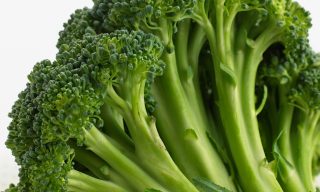 Broccoli is a vegetable you can serve to the whole family because children enjoy it as much as adults. It is also very diet friendly. Besides being very low in calories, it is high in fiber, so it is very filling and nourishing. There are only 44 calories in a whole cup of broccoli, very little sodium, and no fat or cholesterol whatsoever. Broccoli is also very nutritionally dense in many other ways. It is loaded with essential vitamins and minerals and powerful antioxidants which minimize the effect of harmful oxidized free radicals, reduce the risk of degenerative diseases, and help prolong life. Broccoli is a superior source of vitamins C and K, containing approximately double the Daily Value or DV of each. Both vitamins have strong antioxidant properties. Vitamin C strengthens the immune system and makes the body more resistant to many illnesses, while vitamin K is essential for normal blood clotting and helps build strong, healthy bones. Broccoli is also a very good source of vitamin A, folate and other B-complex vitamins, and such minerals as manganese, potassium, phosphorus, and magnesium. A cup of broccoli provides 4.7 grams each of dietary fiber and protein, too.
Broccoli is a vegetable you can serve to the whole family because children enjoy it as much as adults. It is also very diet friendly. Besides being very low in calories, it is high in fiber, so it is very filling and nourishing. There are only 44 calories in a whole cup of broccoli, very little sodium, and no fat or cholesterol whatsoever. Broccoli is also very nutritionally dense in many other ways. It is loaded with essential vitamins and minerals and powerful antioxidants which minimize the effect of harmful oxidized free radicals, reduce the risk of degenerative diseases, and help prolong life. Broccoli is a superior source of vitamins C and K, containing approximately double the Daily Value or DV of each. Both vitamins have strong antioxidant properties. Vitamin C strengthens the immune system and makes the body more resistant to many illnesses, while vitamin K is essential for normal blood clotting and helps build strong, healthy bones. Broccoli is also a very good source of vitamin A, folate and other B-complex vitamins, and such minerals as manganese, potassium, phosphorus, and magnesium. A cup of broccoli provides 4.7 grams each of dietary fiber and protein, too.
Broccoli is also packed with many health-promoting phytonutrients, such carotenoids, which are very important for good eye health, the flavonoids quercetin and kaempferol, and various sulfur compounds, all of which help to fight cancer. Clearly, broccoli is a great addition to anyone’s diet, whether one needs to lose weight or not. To learn more about the different vitamins, minerals, and phytochemicals in broccoli explore the FREE Nutrition Factors Library. Hard to believe that a food that’s as good tasting as broccoli can also be so healthy, but there’s no doubt about it. This colorful and flavorful addition to your menu will bring a smile to even the most finicky eaters.
Broccoli Season
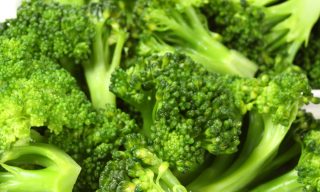 Even though you can probably buy fresh broccoli year-round, it is a cold weather crop that tastes best in the fall and winter. In the U.S., the most common type of broccoli and what you are probably most familiar with is Green Broccoli, for which the peak season is October to April. Some of the other broccoli variations you may see, especially in farmers markets, are Chinese Broccoli (great for Asian soups and stir-fries), Broccolini (a broccoli-kale hybrid), Broccoflower and Broccoli Romanesco (broccoli-cauliflower hybrids), and the intensely flavored, pungent, slightly bitter Broccoli Rabe. During the warmer months, broccoli is less tender and requires longer cooking, which may deplete the vegetable of its nutritional value. Your best bet during the offseason is frozen broccoli. Though not as nutritious as fresh broccoli, it is an acceptable substitute.
Even though you can probably buy fresh broccoli year-round, it is a cold weather crop that tastes best in the fall and winter. In the U.S., the most common type of broccoli and what you are probably most familiar with is Green Broccoli, for which the peak season is October to April. Some of the other broccoli variations you may see, especially in farmers markets, are Chinese Broccoli (great for Asian soups and stir-fries), Broccolini (a broccoli-kale hybrid), Broccoflower and Broccoli Romanesco (broccoli-cauliflower hybrids), and the intensely flavored, pungent, slightly bitter Broccoli Rabe. During the warmer months, broccoli is less tender and requires longer cooking, which may deplete the vegetable of its nutritional value. Your best bet during the offseason is frozen broccoli. Though not as nutritious as fresh broccoli, it is an acceptable substitute.
Broccoli Selection and Storage
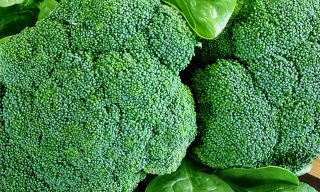 When it comes to broccoli, bigger does not mean better. On the contrary, small heads have better flavor. Both the florets and stalk should be firm and compact. The florets should be an even dark green (or purple) and the stalks lighter in color, but not white or yellow. Don’t buy broccoli with yellowish or bruised florets, wilted leaves, or a strong smell. It is probably overripe or spoiled. Fresh broccoli continues to ripen after harvesting. But you can prolong its shelf life by placing it unwashed in an airtight plastic bag and then refrigerating it. That way an uncut full head will keep for up to a week and a partially cut head will keep a couple of days. However, to preserve its nutritional value, broccoli should not be washed until ready to serve.
When it comes to broccoli, bigger does not mean better. On the contrary, small heads have better flavor. Both the florets and stalk should be firm and compact. The florets should be an even dark green (or purple) and the stalks lighter in color, but not white or yellow. Don’t buy broccoli with yellowish or bruised florets, wilted leaves, or a strong smell. It is probably overripe or spoiled. Fresh broccoli continues to ripen after harvesting. But you can prolong its shelf life by placing it unwashed in an airtight plastic bag and then refrigerating it. That way an uncut full head will keep for up to a week and a partially cut head will keep a couple of days. However, to preserve its nutritional value, broccoli should not be washed until ready to serve.
Broccoli Recipes
It is important not to overcook broccoli or cook it in large amounts of water or at very high temperatures. Steaming is highly recommended. Furthermore, broccoli that is properly prepared doesn’t need any butter, cream sauce, or other fattening ingredients to add flavor. Fresh broccoli, in season, is delicious plain, as is, or lightly seasoned with a splash of lemon or olive oil. Broccoli makes a great pizza topping, too. Or broccoli can be the star ingredient in a very wide variety of healthy dishes such as salads, soups, casseroles, and stir-fries. You will find many delicious broccoli recipes in the Nutrition Factors database. The Broccoli and Bacon Salad and Head to Toe Broccoli Soup recipes included here will whet your appetite for this wonderful fall vegetable and encourage you to eat broccoli a lot more often.
Broccoli and Bacon Salad
Many people may say that bacon makes everything better, which certainly is the case with this classic pairing of crunchy fresh, broccoli with crisp, tasty bacon. Then add in some sweet craisins, a sprinkle of seeds and a healthy salad dressing substitute made from Greek yogurt dressing, and this salad is built to satisfy. For directions, food Nutrition Facts label, and more recipes details CLICK HERE
 INGREDIENTS:
INGREDIENTS:
2 head of broccoli (medium to large)
1/2 c. diced red onion
6 oz. shredded cheddar cheese
6 cooked bacon pieces
3/4 c. plain greek yogurt
2 tbsp apple cider vinegar
2 tbsp sugar or sugar substitute
Optional: 2 tbsp sunflower seeds and 1/4 c. raisins or craisins
Head to Toe Broccoli Soup
This recipe uses all parts of broccoli to make a delicious soup. This creamy soup is a toasty and perfect way to warm up this fall. For Head to Toes details on the directions, and food Nutrition Facts label for this recipe CLICK HERE
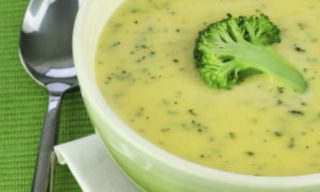 INGREDIENTS:
INGREDIENTS:
1 tbsp olive oil
1 large onion
2 cloves garlic finely chopped
2 whole broccoli
4 cups vegetable or chicken stock
1/2 tsp dried thyme
1/2 tsp dried rosemary
1/4 cup milk
Craving even more Cruciferous? Check out other members of the Cruciferous Family Brussels Sprouts and Cabbage to fill your Cruciferous Cravings until next week’s concluding CRUCIFEROUS blog, Cauliflower!
References
Foster, K. (November 5, 2014). “What’s the Deal with Orange and Purple Cauliflower?”
Retrieved from http://www.thekitchn.com/look-purple- and-orange- cauliflower-ingredient-
intelligence-33348 Mateljan, G. (2007) The world’s healthiest foods. Seattle: George Mateljan Foundation.
Trowbridge Filipponi, P. (February 16, 2017). “Broccoli History.” Retrieved from
https://www.thespruce.com/broccoli-history- 1807573

